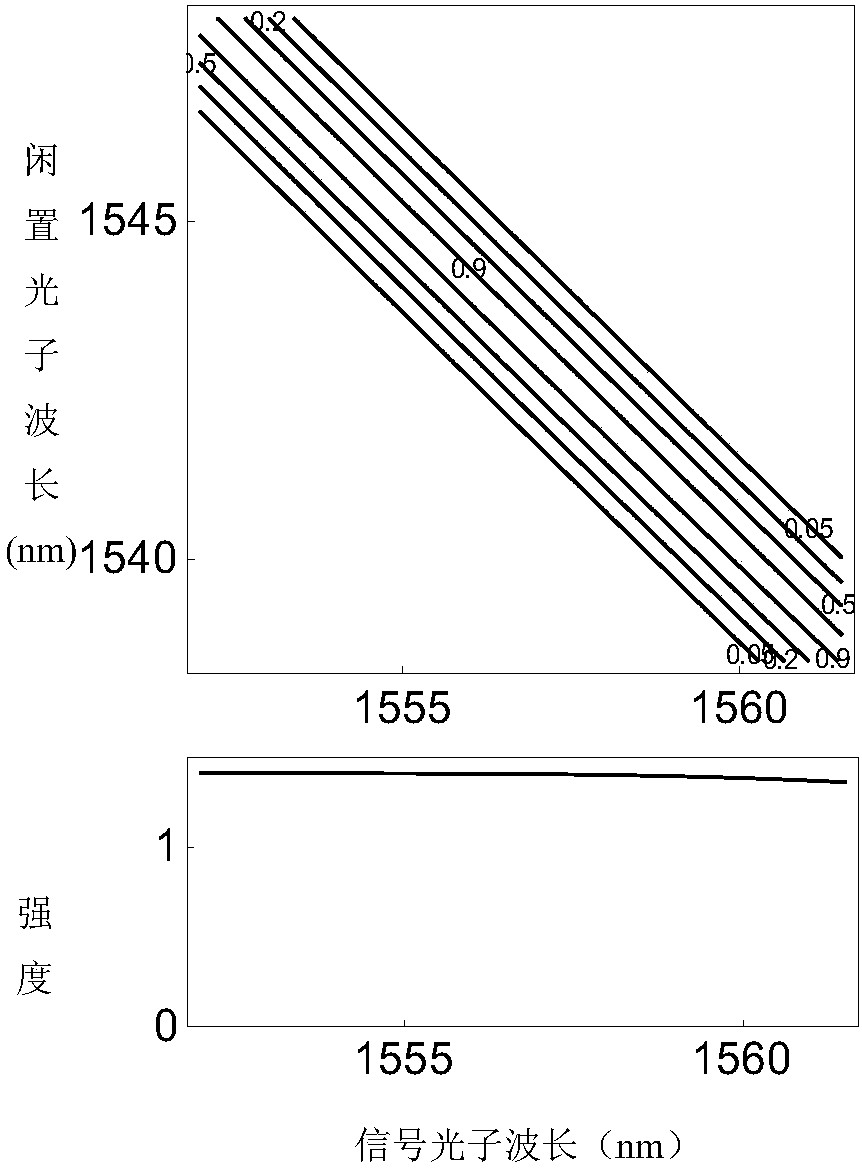Method for controlling frequency spectrum characteristics of quantum correlated photon pairs by quantum interference
A technology of quantum correlation and spectral characteristics, which is applied in the field of controlling the spectral characteristics of quantum correlation photon pairs by quantum interference, can solve problems such as low collection efficiency, difficulty in dispersion characteristics, and reduced collection efficiency, and achieve simple preparation processes, flexible wavelength changes, and wavelength Can effect
- Summary
- Abstract
- Description
- Claims
- Application Information
AI Technical Summary
Problems solved by technology
Method used
Image
Examples
Embodiment 1
[0048] Embodiment 1: Utilize the multi-stage cascade structure based on dispersion-shifted optical fiber and single-mode optical fiber to produce spectrally controllable associated photons. For this embodiment, for example figure 2 As shown, the nonlinear medium in the multi-level cascade structure (number of stages N≥3) is dispersion-shifted fiber, and the length and dispersion of each section of dispersion-shifted fiber are the same, and the length is L U =100m, the zero dispersion wavelength is 1549nm, and the group velocity dispersion slope is 0.075ps / km / (nm) 2 ; The dispersion medium in the multi-level cascade structure is a standard single-mode fiber in the communication band, and the length and dispersion of each single-mode fiber are the same, and the length is L dU =11m, the group velocity dispersion coefficient at 1550nm is 20ps / km / nm. Different segments of optical fiber are welded sequentially. The pulsed pump light used to pump the cascade structure has a standa...
Embodiment 2
[0054] Embodiment 2: Quantum interference between two independent predictive formula pure state single photon sources based on multi-level cascade structure
[0055] Quantum interference between independent single photon sources is the basis of various quantum information technologies. like Figure 4 As shown, the two independent predictive single-photon sources in this embodiment are both based on a three-stage cascaded structure composed of dispersion-shifted optical fibers and single-mode optical fibers, and the structural parameters are the same. In the two predictive single-photon sources, the length and dispersion of each section of dispersion-shifted fiber are the same, the length is 100m, the zero dispersion wavelength is 1549nm, and the group velocity dispersion slope is 0.075ps / km / (nm) 2 ; and the length and dispersion of each single-mode optical fiber are the same, the length is 11m, and the group velocity dispersion coefficient at 1550nm is 20ps / km / nm. Different ...
Embodiment 3
[0057] Embodiment 3: Polarization-entangled photon pair preparation based on multi-level cascade structure
[0058] like Figure 5 As shown, this embodiment adopts a three-stage cascade structure of bidirectional pumping to generate polarization-entangled photon pairs. Figure 5 The cascade structure parameters, pump parameters, multi-channel filters and Figure 4 The corresponding parameters in Example 2 shown are the same. The pulsed pump light enters the polarization beam splitter with a linear polarization direction of 45 degrees, and is divided into two beams whose polarization direction is parallel to the paper surface and perpendicular to the paper surface. A beam whose polarization direction is parallel to the paper is input into the three-stage cascade structure clockwise, and the signal and idler frequency associated photon pairs with the same polarization direction as the pump light are generated through the four-wave mixing process (with |H> s |H> i ); and a be...
PUM
| Property | Measurement | Unit |
|---|---|---|
| length | aaaaa | aaaaa |
| wavelength | aaaaa | aaaaa |
| wavelength | aaaaa | aaaaa |
Abstract
Description
Claims
Application Information
 Login to View More
Login to View More - R&D
- Intellectual Property
- Life Sciences
- Materials
- Tech Scout
- Unparalleled Data Quality
- Higher Quality Content
- 60% Fewer Hallucinations
Browse by: Latest US Patents, China's latest patents, Technical Efficacy Thesaurus, Application Domain, Technology Topic, Popular Technical Reports.
© 2025 PatSnap. All rights reserved.Legal|Privacy policy|Modern Slavery Act Transparency Statement|Sitemap|About US| Contact US: help@patsnap.com



